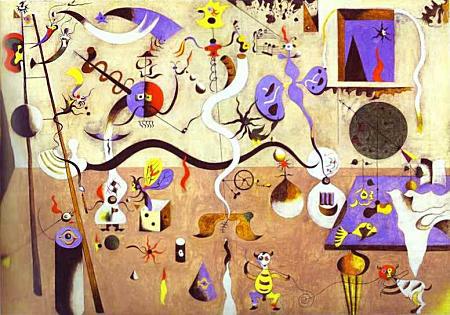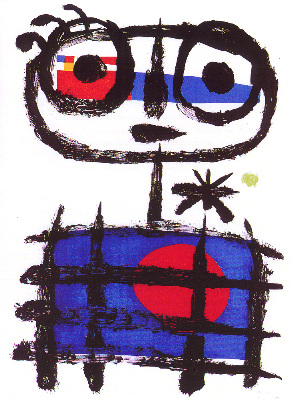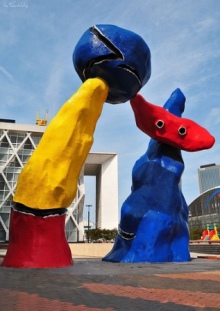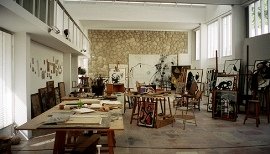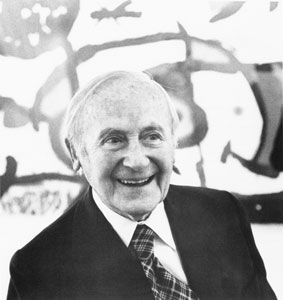
|
|
MIRÓ
SLIDESHOW OF SOME MORE OF MIRO`S WORK
|
Brief chronology
1893 Born to Miguel Miro I Adzerias and Dolores Ferra I Oromi
1900 Starts primary school and drawing classes with Mr Civil Summers with paternal grandparents in Cornudella and Mallorca.
1907 Attends Barcelona School of Commerce. Goes to classes at La Llotja School of Fine Art.
1910 Trainee accountant in Barcelona.
1911 Dislikes job and catches typhoid fever – convalesces at the farmhouse in Montroig.
1912 Joins classes at the Francesc Gali Art School in Barcelona until 1915.
1913 Studies drawing at sant Lluc Art Circle until 1918.
1914 Shares a studion with Ricart in Barcelona.
1915 Military service for three months a year until 1917.
1916 Meets Josep Dalmau, the arts dealer. Starts painting landscapes and still life with a strong influence from Cezanne, Van Gogh, Matisse and the Fauve movement.
1918 First solo exhibition at the Dalmau Galeries in Barcelona.
1920 Takes first trip to Paris where he meets Picasso.
1921 Organises a studio in Paris and starts to paint ‘The Farm’
1922-24 Completes ‘The Farm’ during summers at Montroig. Continues to develop his art in Paris.
1925 Shows ‘Catalan landscape’ (The Hunter) is Surrealist exhibition.
1926 Develops costumes and stage set with Max Ernst for Diaghilev.
1927 Expresses a desire to assassinate painting.
1928 Creates his first ‘collage-painting’ which he called ‘Spanish dancer’, from found objects and extending into three dimensions.
1929 Marries Pilar Juncosa in Palma de Mallorca.
1930 Their only child, Maria Dolores is born.
1931-6 Divides time between Paris, Barcelona and Montroig. Exhibits internationally and first solo show at Pierre Matisse Gallery, New York.
1936-8 Spanish Civil War breaks out, so stays in Paris where his family join him.
1939 World War II breaks out and Franco dictatorship begins.
1940 The war forces the family to return to Spain and settles with Pilar’s family in Palma.
1940-4 Shares his time between Barcelona, Palma and Montroig. International exhibitions including first major retrospective at Museum of Modern Art, New York.
1944 Collaboration for first time with Josep Llorens Artigas on ceramics.
1945 Makes terracotta model for first bronze sculpture: Oiseau solaire.
1946-55 International exhibitions and commissions including mural for Harvard University,USA
1955 Concentrates on ceramics with Artigas, culminating in the UNESCO mural of 1958
1956 Sert studio, Palma, completed.
1957 Based in Palma with trips to Barcelona, Artigas’ studio in Gallifa, Montroig and Paris. Visits sources of inspiration for UNESCO mural including Altamira caves, Catalan Romanesque paintings and architecture by Gaudi in Barcelona.
1959 Buys Son Boter, and 18th century farmhouse, as large studio for sculpture, painting and a printshop.
1960 Works with Artigas and his son Joan Gardy Artigas on ceramics.
1961-2 Completes several major painting series including Blue triptych.
1963 Collaborates with Sert and Artigas on ceramic sculptures for Fondation Maeght, Saint-Paul-de-Vence.
1966 Works on monumental bronzes beginning with L`Oiseau solaire and L`Oiseau lunaire.
First painted bronze sculptures.
1969 Interest in sculpture and print making intensifies.
1971-4 International exhibitions including Miró Sculptures at Hayward Gallery, London.
1975 Unofficial opening of the Joan Miro Foundation in Barcelona designed by Sert.
1976 Creates characters for the play Mori el Merma.
1981 Establishment of the Fundacio Pilar i Joan Miró a Mallorca.
Inauguration of monumental sculptures Moon, sun and one star, Chicago, and Personage and birds, Houston, Texas
1983 Dies at his home in Palma on 25 December.
Copyright © and TM 2007-2024 fun-learning-spanish.com |
